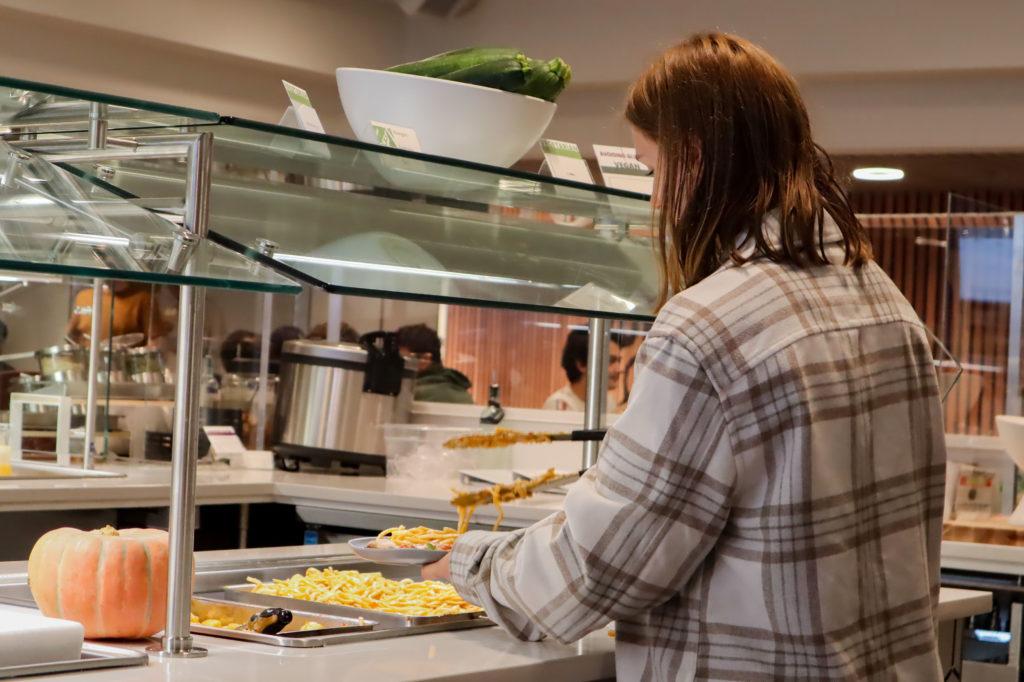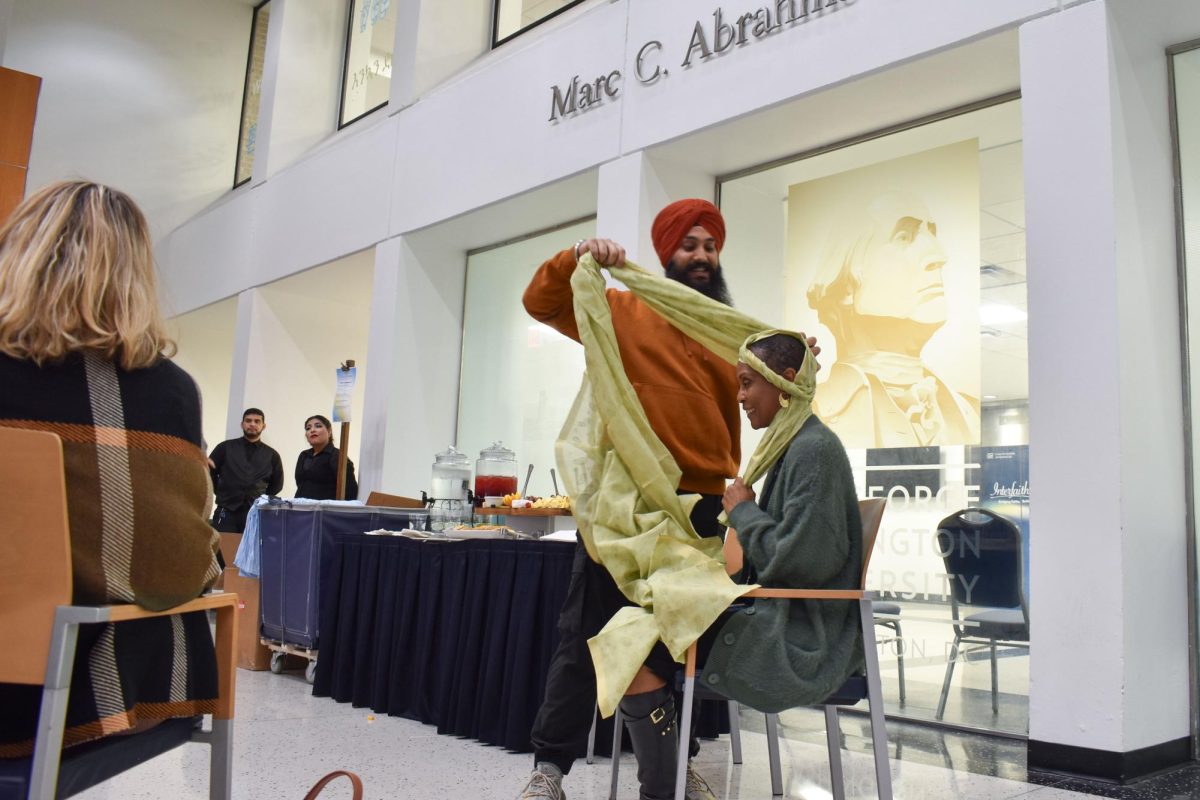After GW opened a dining hall in Foggy Bottom for the first time in seven years earlier this month, students said the venue is a convenient spot for quality food, but low capacity and unclear nutrition labels keep it from maximizing its potential.
Located in the basement area of the newly renovated Thurston Hall, the dining area features an assortment of options ranging from smaller snacks to larger meals during three dining periods each weekday and brunches and dinners on weekends. Twenty-five students said the hall offers a wide array of affordable meal options in a comfortable community space, but some criticized the high wait times that low capacity can cause and a lack of thorough signage for allergen-free food.
Vice President of Business Services Seth Weinshel said in an interview the dining hall can serve 750 to 800 students during four-and-a-half hour dinner periods, which bring in more diners than the hall’s breakfast and lunch periods. He said the communal space has brought GW community members together to share affordable meals in a dining hall for the first time since officials closed GW’s previous dining hall, J Street, in 2016.
“We see a number of faculty and staff and University leadership going, so it’s really doing some of that building of community that we anticipated,” Weinshel said.
The hall offers staples like pizza and pasta daily, but Thurston’s nine dining stations switch up most of its options each day, with chefs building menus that include deli-style sandwiches, international cuisines and more. Students are free to take fruit like bananas and apples from bowls placed along the walls of the dining hall, and items like cereal, cookies and yogurt are available during each dining period.
Students pay a set fee upon entering the dining hall, which charges $8 during breakfast, $10 during lunch and $12 during dinner before tax, and they can take as much food as they want while inside. Most students said Thurston’s dining hall has high-quality food and is relatively affordable, but some criticized operational elements of the area, with a handful of diners citing long wait times and unclear food labels.
Thurston’s dining hall has an official seating capacity of 225, which lags behind dining halls on Georgetown, American and Howard universities campuses, despite the student populations of those colleges being less than GW’s.
Freshman Kate Amistoso, a Thurston resident who usually goes to the dining hall twice a day, said the relatively low capacity was “frustrating” when she’s on a busy schedule. She said she’s excited to be able to get quicker and smaller items like fruit on the pre-paid, unlimited swipe plan next semester without having to pay an $8 entry fee.
“I won’t be worrying as much if I need to just come down here and quickly grab that versus paying 11 or eight dollars for it,” Amistoso said.
Beginning next semester, the University will fully transition to its new dining plan, which will give unlimited dining swipes and a GWorld dining dollar stipend for freshmen for a total cost of at least $2,700. Upperclassmen will be able to choose from eight plans, which range from the unlimited dining swipes plan to the $1,670 “legacy” plan that mirrors the pre-existing dining dollar plan.
Students shared mixed feelings on the transition – some prefer the flexibility of dining dollars so they’re not overly reliant on Thurston for meals, and others enjoy the convenience of more swipes and quick access to smaller snacks and meals.
Senior Hasna Chowdhury, who works part-time at Thurston’s front desk, has noticed increased student presence going downstairs from the lobby to the dining hall, which she said has “overwhelmed” the building’s security guards during the 4:30 to 9 p.m. dinner period. Chowdhury said food like the pizza and onion rings were “pretty good,” and she felt community members with different preferences could all enjoy a meal.
“I think it’s worth it,” Chowdhury said. “I feel because there’s so many options here, once you swipe at the front it’s all you can eat, and I think that’s a versatile palate for students who come in to decide what they want.”
Emma Curry, a freshman majoring in journalism and mass communication, said dining hall staff helped her find a meal that fit her gluten-free diet, part of what has made for a positive dining experience overall.
“They were very accommodating,” Curry said. “When I asked, they were like, ‘Do you want a chef to walk you around and help you out?’”
The dining hall features an allergen-free station called Pure Eats, which offers products free of gluten, milk, peanuts, tree nuts, egg, shellfish, fish and soy, according to GW’s website. Staff members prepare the food in stations with separate utensils and kitchenware, the website states.
Kayla Greenfeld, a freshman majoring in international affairs, said she prefers Thurston’s dinner offerings over lunch and breakfast because a wider variety of foods are available in the evening. She said a she finds the broad array of options to be especially valuable because she is lactose intolerant and kosher.
“I’m picky, which is sometimes difficult, but other than that I’m excited I can basically eat unlimited food,” Greenfeld said.
Olivia Earley, a freshman majoring in political science and dance, said the dining hall is “well operated,” but a lack of complete ingredient lists near the food makes it unclear which allergens could be in specific foods. Food options at Thurston do not have comprehensive ingredient lists, though common allergens, like dairy and nuts, are labeled.
“I feel like there could be more labeling on some of the options just because I have a few allergies, so I don’t really know what I’m picking sometimes,” Earley said.
Isabel Sesin, a freshman majoring in political science who eats at Thurston’s dining hall about five times a week, said she is unsure whether the venue will be able to accommodate students after the transition to the meal swipe system next semester because students will be more likely to eat dining hall meals with fewer dining dollars on hand.
“I feel that it’ll just be harder to manage because you won’t be able to get as much food outside of dining halls, and this place is pretty small,” Sesin said. “I feel like if this is the only source of food that you can get. That’s going to suck when everyone has to come here.”
Officials plan to open a second all-you-can-eat dining hall in Shenkman Hall for the spring semester after months of delays due to supply chain issues. Officials planned to convert the basement of District House into one of three all-you-can-eat dining halls in Foggy Bottom, but they deviated from those plans over the summer in favor of a traditional vendor set up, citing supply chain issues as among the reasons for the delays.
Freshman Joey Levi, a resident of Thurston Hall who goes to the dining hall once or twice a day, said he doesn’t like that the dining dollar program will be phased out because he prefers the flexibility of dining dollars. Levi said the current $2,700 dining dollar balance for freshmen “is a lot nicer” than the unlimited swipe plan.
“I love having the option of going out to a bunch of places if I don’t feel like eating here,” Levi said.
Grace Chinowsky, Henry Huvos, Lydie Lake and Zach Blackburn contributed reporting.











